Beverage Deep Dives
Craft Coffee: From Bean to Cup
Nestled in the rich history and vibrant flavors of craft coffee lies a captivating journey that unveils the art of creating the perfect cup.
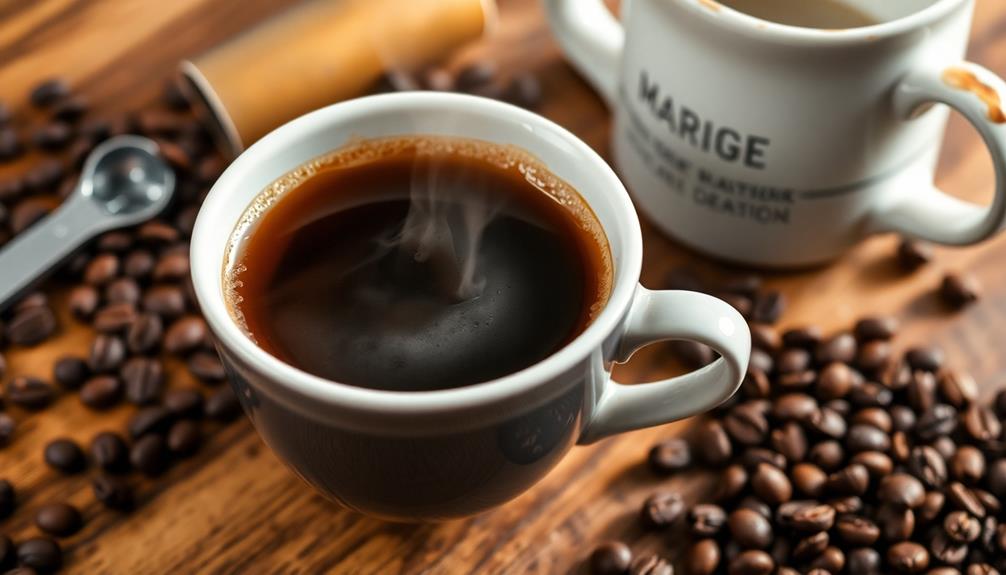
Craft coffee takes you on a delightful journey, from the rich aromas of freshly-roasted beans to the perfect cup brewed just for you. This age-old tradition traces back to Ethiopia, then spread across the Arab world and into Europe. Today's craft coffee movement celebrates quality, sustainability, and artistry. You'll discover unique flavors influenced by the bean's origins, as well as roasting and brewing techniques that unlock its full potential. Experiment with different bean varieties, roast levels, and brewing methods to find your personal favorites. Each sip reveals new dimensions of taste, inviting you to explore the wonders of craft coffee further.
Key Takeaways
- The craft coffee movement emphasizes quality, sustainability, and artistry in sourcing, roasting, and brewing high-quality beans for unique flavor profiles.
- Proper bean selection, roasting techniques, and brewing methods are crucial for extracting the optimal flavors and aroma from freshly-ground coffee.
- Different brewing methods like drip, French press, and pour-over offer distinct experiences, requiring adjustments in grind size, water temperature, and brew time.
- Flavor profiles in craft coffee can include a range of notes, from fruity and nutty to chocolatey, with varying levels of acidity and body.
- The craft coffee culture fosters a sense of community and appreciation for the art and skills involved in creating the perfect cup of coffee.
History
The origins of craft coffee can be traced back to the 15th century, when coffee beans were first discovered in the highlands of Ethiopia.
These precious beans quickly spread across the Arab world and eventually made their way to Europe. Coffee houses popped up in major cities, becoming hubs of social activity and intellectual discourse.
Over the centuries, coffee cultivation expanded to other tropical regions, with each area developing its own unique flavors.
As coffee grew in popularity, new techniques for roasting, grinding, and brewing emerged. Coffee connoisseurs began to appreciate the nuances of different beans, origins, and preparation methods.
Today, the craft coffee movement celebrates this rich history, focusing on quality, sustainability, and the art of the perfect cup.
From small-batch roasters to high-tech brewing gadgets, the world of craft coffee invites you to explore, experiment, and savor the flavors of this beloved beverage.
Recipe
Crafting the perfect cup of coffee requires a delicate balance of ingredients and preparation. The art of brewing coffee isn't merely a means to an end, but a journey of discovery, where the subtle nuances of flavor and aroma can transport one to distant lands and awaken the senses.
At the heart of this experience lies the recipe, a carefully curated set of steps that, when followed with precision, can elevate a simple beverage into a sublime elixir.
Let's embark on this journey together and uncover the secrets to crafting the ultimate cup of craft coffee.
Ingredients:
- 2 tablespoons freshly ground coffee
- 6 ounces filtered water
- 1 paper filter
- 1 kettle or saucepan
Instructions:
Bring the filtered water to a gentle simmer in a kettle or saucepan. While the water is heating, place the paper filter in the coffee maker or a pour-over device. Add the freshly ground coffee to the filter, ensuring an even distribution.
Once the water has reached the desired temperature, slowly pour it over the grounds, making sure to saturate the entire surface. Allow the coffee to brew for 4-5 minutes, then serve immediately.
It's important to note that the quality of the coffee beans, the grind size, and the water temperature all play a crucial role in the final flavor profile.
Experiment with different bean origins, roast levels, and brewing techniques to discover your personal preference. Embrace the art of craft coffee and savor each sip as a unique experience.
Cooking Steps
To craft the perfect cup of coffee, start by selecting high-quality beans and grinding them to your desired coarseness.
Next, brew the coffee using your preferred method, carefully adjusting the water temperature and brew time to ensure maximum flavor.
Step 1. Select High-Quality Coffee Beans
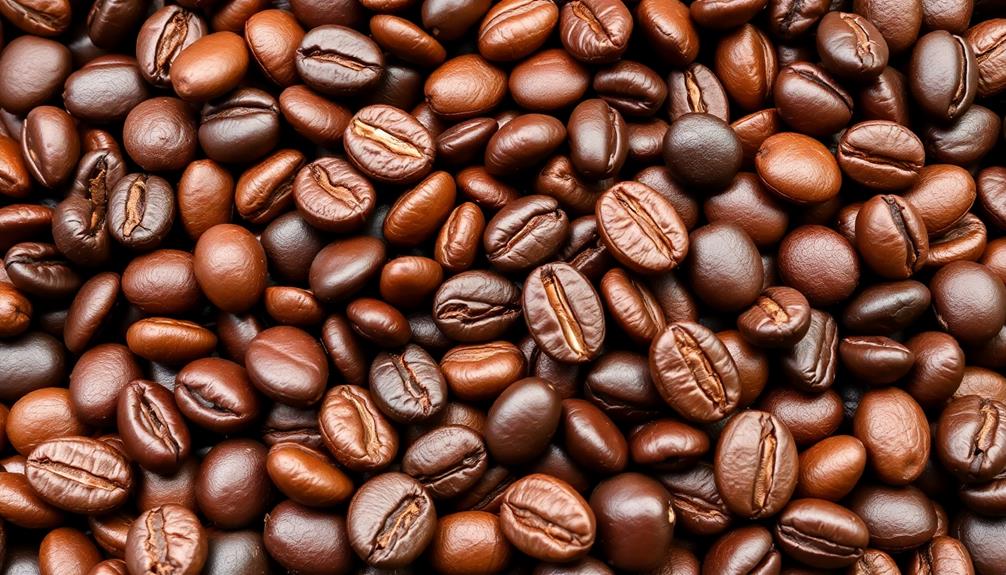
Selecting high-quality coffee beans is the foundation for crafting an exceptional cup of coffee. The journey to the perfect brew begins with choosing the right beans.
Look for beans that are freshly roasted, with a vibrant aroma and rich, complex flavors. Coffee also contains antioxidants that combat oxidative stress, enhancing its health benefits.
Explore different origins, such as the smooth and balanced beans from Central America or the bold, fruity notes of African coffees. Pay attention to the roast level too – light roasts offer brighter acidity, while dark roasts have a deeper, richer taste.
Once you've found the perfect beans, store them properly in an airtight container in a cool, dry place.
Grind them just before brewing to unlock all those delightful aromas. With high-quality beans, you're well on your way to creating a truly remarkable cup of craft coffee!
Step 2. Grind Beans to Desired Coarseness
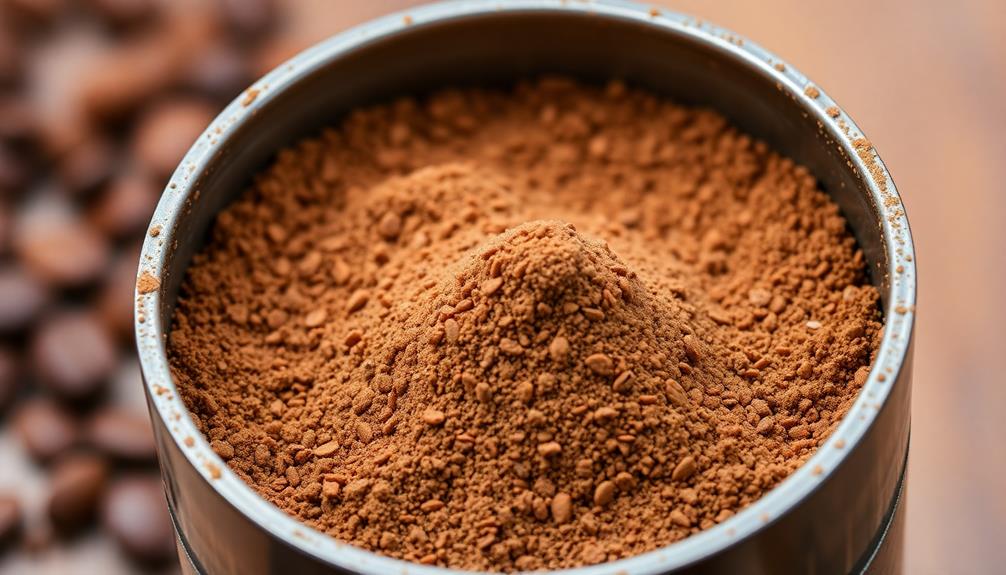
Once you've secured the perfect coffee beans, it's time to grind them to your desired coarseness. This step is crucial, as the grind size can significantly impact the flavor and strength of your brew. Grab your trusty burr grinder and get ready to unlock the full potential of those premium beans!
Whether you prefer a bold, full-bodied cup or a smooth, delicate sip, the right grind size is key. For a French press, go for a coarse grind, allowing the robust flavors to shine. For a pour-over, aim for a medium grind that will produce a balanced, nuanced taste. And for an espresso, you'll want a fine grind to create that thick, intense crema.
Take your time and experiment to find the perfect grind for your taste buds. Listen to the satisfying whir of the grinder and breathe in the enticing aroma as the beans transform into a fine, aromatic powder.
With a little practice, you'll be a true coffee connoisseur, crafting the perfect cup every time.
Step 3. Brew Coffee Using Desired Method
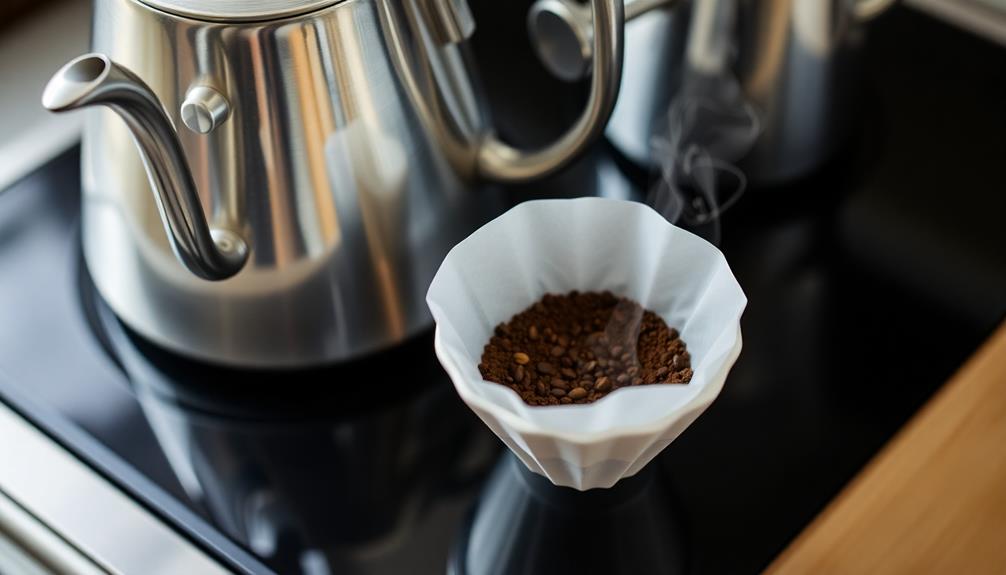
Now that you have the perfect grind, it's time to brew your coffee! Grab your favorite brewing method, whether that's a classic drip machine, a sleek French press, or a pour-over setup.
Fill your kettle with fresh, cold water and bring it to a gentle simmer. While you wait, take a deep breath and inhale the tantalizing aroma of your freshly ground beans.
When the water is ready, carefully pour it over the grounds, letting the coffee bloom and release its rich flavors. Depending on your brewing method, you may need to stir gently or let the coffee steep for a few minutes.
Be patient and let the process unfold – great coffee is worth the wait!
As the final drops drip into your cup, take a sip and savor the balanced, smooth taste. Congratulations, you've just brewed a delectable cup of craft coffee!
Now sit back, relax, and enjoy the fruits of your labor.
Step 4. Adjust Water Temperature and Brew Time
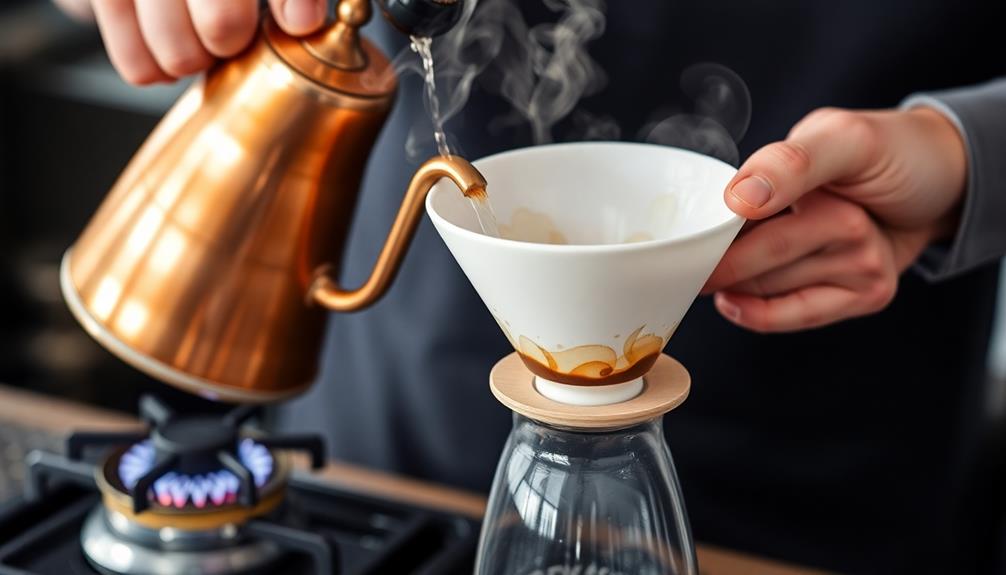
To brew the perfect cup of craft coffee, adjusting the water temperature and brew time is crucial.
You'll want to aim for water that's around 200°F. Any hotter, and you might end up with a bitter, burnt taste. Any cooler, and the coffee will be weak and watery. Get your water to the right temp, then slowly pour it over the freshly ground coffee beans.
The perfect brew time depends on the method you're using, but a general rule is 4-6 minutes.
Any shorter and the flavors won't fully develop. Longer, and you risk over-extraction, which makes the coffee taste sour and unpleasant. Keep an eye on the clock and adjust as needed.
With the right water temp and brew time, you'll create a rich, smooth cup of craft coffee that's bursting with flavor. Enjoy!
Step 5. Enjoy the Freshly Brewed Coffee

Typically, you'll want to pour the freshly brewed coffee into your favorite mug or cup. The aroma will immediately fill the air, inviting you to take a deep breath and savor the moment.
As you bring the cup to your lips, the warmth radiates through your hands, adding to the cozy experience.
Take a sip and let the bold, complex flavors dance on your tongue. Notice the subtle notes of chocolate, caramel, or even a hint of fruitiness, depending on the coffee beans used. The perfectly extracted brew should have a smooth, velvety mouthfeel, neither too weak nor too bitter.
Enjoy the coffee at your own pace, savoring each sip. You can add a touch of cream or sugar if desired, but try the coffee black first to truly appreciate the craftsmanship.
With each taste, you'll discover new layers of flavor, making every cup a unique and rewarding experience.
Final Thoughts
As we reach the conclusion of our exploration into the world of craft coffee, it's clear that this vibrant industry has much to offer.
From the delightful aroma of freshly-ground beans to the satisfying sip of a perfectly-brewed cup, the joys of craft coffee are truly endless. Whether you're a seasoned coffee connoisseur or just discovering the wonders of this beloved beverage, there's always more to learn and savor.
Craft coffee isn't just about the end result – it's a journey of discovery, where each step, from bean selection to brewing technique, plays a crucial role in creating the ultimate coffee experience.
Frequently Asked Questions
What Is the Best Way to Store Roasted Coffee Beans?
The best way to store roasted coffee beans is to keep them in an airtight container, away from light, heat, and moisture. Avoid storing them in the fridge or freezer, which can lead to condensation and staling.
How Can I Tell if My Coffee Beans Are Fresh?
You can tell if your coffee beans are fresh by their aroma. Fresh beans will have a rich, distinct scent. You can also check the roast date and avoid beans that are more than a few weeks old.
What Is the Difference Between Arabica and Robusta Coffee Beans?
Arabica and Robusta are the two main coffee bean varieties. Arabica beans have a sweeter, more complex flavor, while Robusta beans are more bitter and contain more caffeine. The choice between the two depends on your personal taste preferences.
How Can I Reduce Bitterness in My Homemade Coffee?
To reduce bitterness in your homemade coffee, try using a coarser grind, brewing at a lower temperature, and limiting the brew time. You can also add a pinch of salt or a splash of milk to counteract the bitterness.
What Are the Health Benefits of Drinking Craft Coffee?
Drinking craft coffee can provide several health benefits. It's rich in antioxidants that may reduce inflammation, improve cognitive function, and lower the risk of chronic diseases like type 2 diabetes and certain types of cancer.
Beverage Deep Dives
Kombucha Brewing: Fermented Tea at Home
Satisfy your thirst and rejuvenate your gut with the homemade elixir of Kombucha, a centuries-old fermented tea that brews vibrant flavors right in your kitchen.
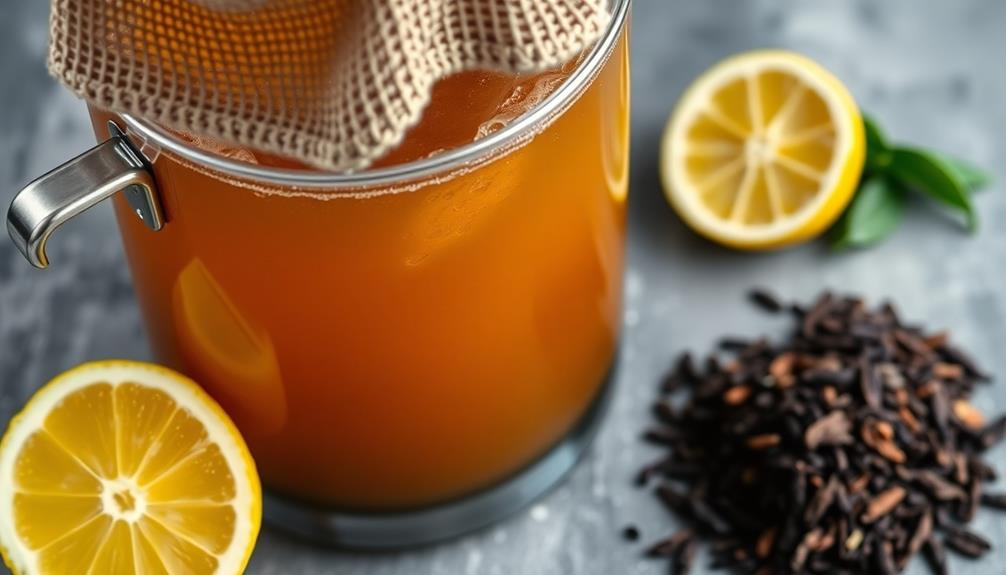
Get ready to whip up your own bubbly, tangy, and health-boosting elixir right at home! Kombucha, that fermented tea marvel, has been revered for centuries as an "Immortal Health Drink." With just a few simple ingredients – like tea, sugar, and a special culture called a SCOBY – you can create your very own probiotic powerhouse. The brewing process is easy, though it does take some patience as the tea ferments over 1-2 weeks. But the payoff is a refreshing, customizable beverage full of beneficial bacteria. So gather your supplies and get ready to dive into the rich history and modern benefits of homemade kombucha!
Key Takeaways
- Obtain a SCOBY, which is essential for fermenting the sweet tea solution to create kombucha.
- Prepare a sweet tea solution by boiling water, steeping tea bags, and dissolving sugar, then allowing it to cool.
- Add the SCOBY and starter liquid to the sweet tea, cover, and let it ferment for 7-14 days to develop the desired tartness.
- Bottle the fermented kombucha, leaving headspace for carbonation, and optionally add sugar or fruit juice for enhanced fizziness.
- Experiment with various fruit juices, herbs, and spices to create unique flavor profiles and explore the health benefits of homemade kombucha.
History
The origins of kombucha can be traced back thousands of years, with early records of its consumption dating as far back as 221 BC in ancient China. Back then, this fizzy, fermented tea was revered for its purported health benefits and was even called the "Immortal Health Elixir."
Over the centuries, the recipe and preparation of kombucha spread to other parts of the world, including Russia, Japan, and Eastern Europe.
Today, kombucha has become a popular health drink, enjoyed for its tangy, slightly sweet flavor and its potential to support gut health.
As you brew your own kombucha at home, you're continuing a tradition that has spanned millennia. With each sip, you're connecting to the rich history of this unique and fascinating beverage.
Who knows – maybe your homemade kombucha will even grant you a touch of immortality!
Recipe
Kombucha is a fermented tea that has been enjoyed for centuries for its potential health benefits and unique flavor profile. Brewing kombucha at home allows you to customize the taste and control the ingredients. This recipe will guide you through the process of creating your own delicious kombucha at home.
Kombucha is made by fermenting sweetened black or green tea with a symbiotic culture of bacteria and yeast, commonly referred to as a SCOBY. The fermentation process transforms the sugary tea into a slightly effervescent, slightly tart beverage that can be further flavored to suit your preferences.
- 4 cups filtered water
- 4 tea bags (black or green tea)
- 1/2 cup white sugar
- 1 SCOBY (Symbiotic Culture of Bacteria and Yeast)
- 1/2 cup unflavored kombucha (from a previous batch or store-bought)
To brew the kombucha, bring the water to a boil, then remove from heat and steep the tea bags for 5-7 minutes. Discard the tea bags and stir in the sugar until it has completely dissolved.
Allow the sweetened tea to cool to room temperature. Once cooled, pour the tea into a clean, non-reactive container (such as a glass jar) and add the SCOBY and unflavored kombucha. Cover the container with a coffee filter or breathable cloth and secure it with a rubber band.
Allow the mixture to ferment at room temperature for 7-14 days, tasting it periodically to achieve your desired flavor and level of carbonation.
When the kombucha has reached your preferred taste, remove the SCOBY and reserve it for your next batch. You can then bottle the kombucha and let it sit at room temperature for an additional 1-3 days to further develop the carbonation.
Refrigerate the bottled kombucha and enjoy your homemade creation! Be sure to keep the SCOBY well-fed and stored in a small amount of kombucha to maintain its healthy condition for future batches.
Cooking Steps
Alright, let's get started on that homemade kombucha!
First, you'll need to obtain a SCOBY, a.k.a. the "mother" culture that helps ferment the tea.
Next, prepare a sweet tea solution and add your culture, then let it ferment for a bit.
Step 1. Obtain a SCOBY
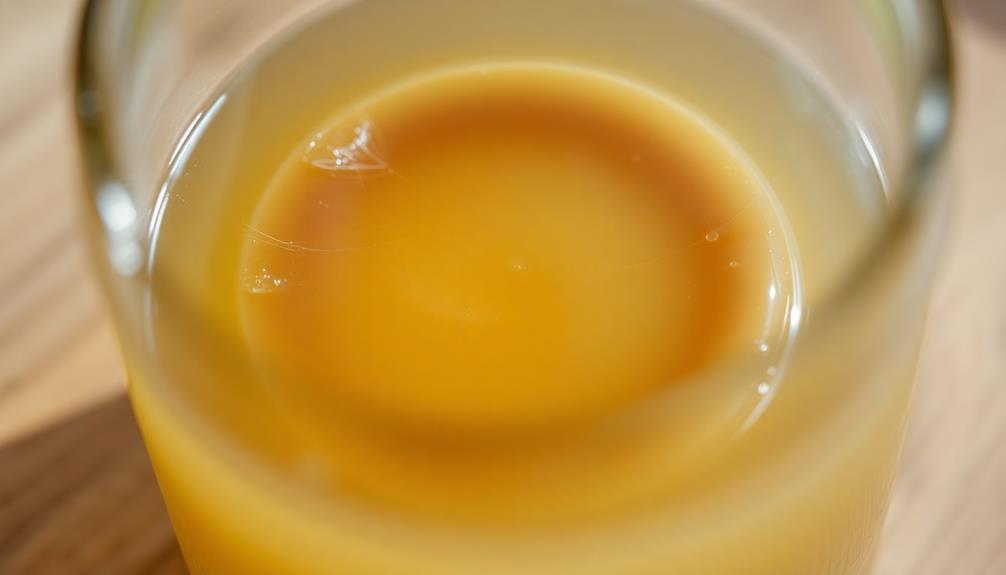
Acquiring a symbiotic culture of bacteria and yeast, or SCOBY, is the fundamental first step in your kombucha brewing journey. This amazing living organism is the heart and soul of your bubbly, tart, and healthy beverage.
Don't worry, you can easily get your hands on one! You can find SCOBYs online, at local brewing supply stores, or even ask friends who brew kombucha if they can share a slice of theirs.
When you receive your SCOBY, it will look like a thick, gelatinous pancake – don't be alarmed, that's perfectly normal! Gently place it in the vessel you'll be using for fermentation, along with the starter tea that came with it. This liquid contains all the essential bacteria and yeast your SCOBY needs to thrive.
With your SCOBY safely tucked in, you're well on your way to crafting delicious homemade kombucha. Just follow the remaining steps, and you'll be sipping your own fizzy creation in no time!
Step 2. Prepare Sweet Tea Solution
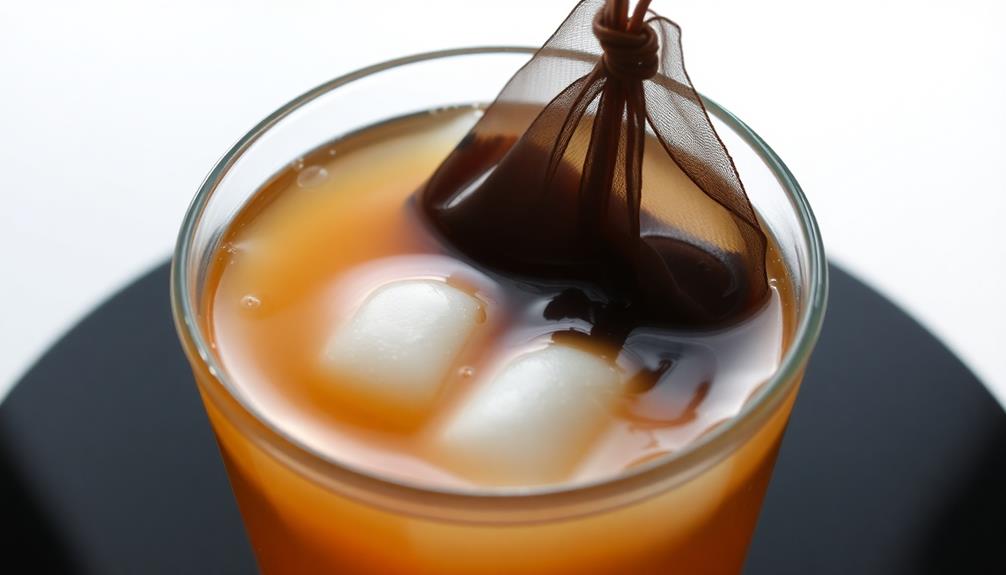
Brewing the perfect kombucha starts with crafting a sweet tea solution. First, gather your ingredients – black tea, sugar, and fresh, clean water.
Bring the water to a rolling boil in a large pot. Then, remove the pot from the heat and add the tea bags or loose-leaf tea. Let the tea steep for about 5-7 minutes, allowing the robust flavors to infuse the water.
Next, stir in the sugar until it completely dissolves. The ratio is typically 1 cup of sugar per 1 gallon of water. Make sure to use white, granulated sugar for best results.
Allow the sweet tea to cool completely before moving on to the next step. You want the temperature to be around room level, about 70-80°F.
Once the sweet tea is ready, it's time to pour it into your fermentation vessel. This could be a glass jar, mason jar, or even a large ceramic crock.
Be gentle when adding the SCOBY and starter liquid to avoid disrupting the delicate culture.
Step 3. Add Culture and Ferment
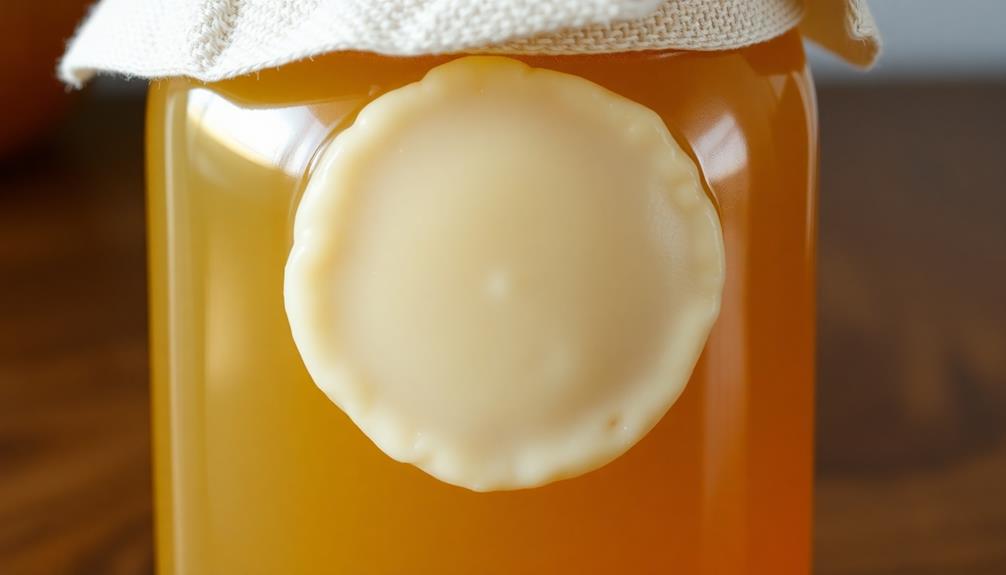
Once you've poured the cooled sweet tea into your fermentation vessel, it's time to add the SCOBY (Symbiotic Culture of Bacteria and Yeast) and starter liquid. This is the fun part! Gently place the SCOBY on top of the tea and pour in the starter liquid.
The SCOBY looks a bit like a flat, rubbery mushroom cap, and it's the heart of your kombucha operation. It will float on the surface and begin to work its magic, converting the sugars in the tea into tangy, fizzy kombucha. Using high-quality ingredients is essential, as it can enhance the flavor and health benefits of your brew, similar to the way herbal teas provide unique flavors.
Now, cover the vessel with a breathable cloth and secure it with a rubber band or string. This allows air to circulate but keeps out dust and insects.
Place your covered vessel in a warm, dark spot and let the fermentation begin. Over the next 7-14 days, the SCOBY will grow and the kombucha will develop its signature tartness. Keep an eye on it, and when it's ready, you can bottle it up and enjoy your very own homemade kombucha!
Step 4. Bottle and Carbonate the Kombucha
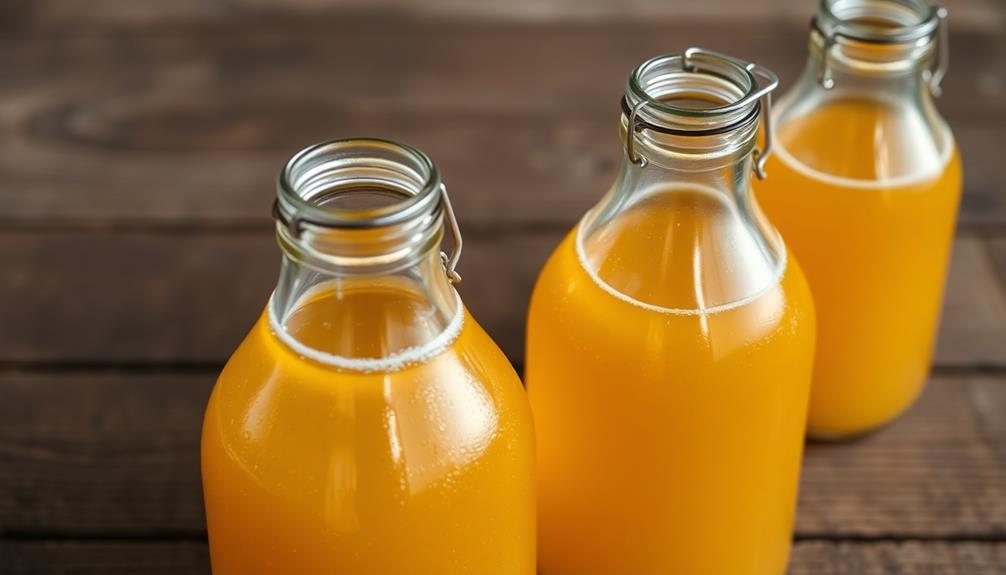
After the fermentation period, it's time to bottle and carbonate your kombucha! This is where the magic really happens. Get ready to watch your brew fizz and bubble to life.
First, use a funnel to carefully pour the fermented kombucha into clean bottles, leaving about an inch of headspace at the top. To enhance the flavor and health benefits, consider using different sugars that can influence fermentation speed.
Now, add a touch of sugar or fruit juice to each bottle – this will kickstart the carbonation process. Tightly seal the bottles and let them sit at room temperature for 2-4 days. You'll know it's ready when the bottles feel nice and firm.
Be careful when opening, as the kombucha will be bubbly and carbonated! Once it's carbonated to your liking, pop those bottles in the fridge to stop the fermentation.
Congratulations, you've brewed your very own batch of delicious, fizzy kombucha! Sip and enjoy the tangy, effervescent goodness. Yum!
Step 5. Enjoy Your Homemade Kombucha!
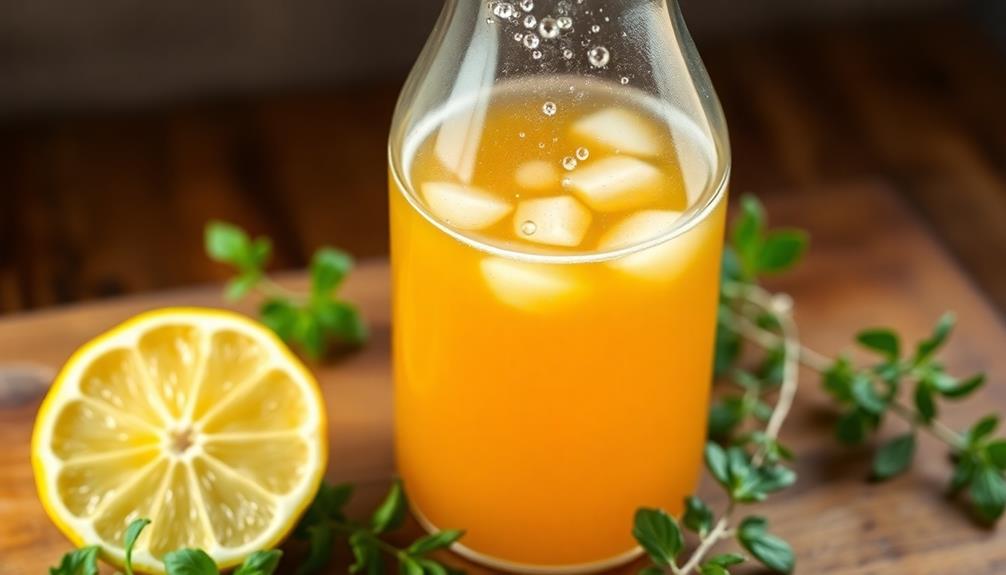
With your kombucha now carbonated and chilled, it's time to savor the fruits of your labor! Grab a tall glass and pour in the bubbly, amber-colored liquid. Isn't it just gorgeous?
Take a big whiff – can you smell the tangy, slightly sweet aroma? That's the magic of fermentation at work. Now, take a sip and let the refreshing flavors dance on your tongue. Feel how the carbonation tickles your taste buds. Isn't it so satisfying?
As you enjoy your homemade kombucha, consider adding a slice of lemon or a few berries to enhance the flavor. You can also experiment with different fruit juices or herbs to create unique taste combinations. The possibilities are endless!
Sit back, relax, and feel proud of yourself for brewing up this delicious, probiotic-rich beverage. With each sip, you're nourishing your body and treating your taste buds. Cheers to your homemade kombucha success!
Final Thoughts
Brewing kombucha at home can be a rewarding and cost-effective endeavor. Imagine the satisfaction of sipping your very own homemade fizzy, tangy tea – a refreshing and healthy alternative to sugary sodas.
As you've learned, the process is quite simple, and with a little practice, you'll be brewing batches like a pro.
Don't be afraid to experiment with different flavors and ingredients. Try adding fresh fruit, herbs, or spices to customize your kombucha to your taste buds. The possibilities are endless!
Remember, the keys to success are patience and attention to detail. Keep a close eye on your SCOBY, maintain a clean brewing environment, and adjust the fermentation time as needed.
Soon, you'll be impressing your friends and family with your homemade kombucha skills.
Frequently Asked Questions
How Long Does Kombucha Take to Ferment at Home?
Typically, homemade kombucha fermentation takes between 7-14 days. The exact time can vary depending on factors like temperature, sugar content, and your personal preference for taste. Be patient and taste it regularly to achieve your desired flavor profile.
Can I Use Green Tea Instead of Black Tea?
You absolutely can use green tea instead of black tea to brew kombucha at home. The fermentation process will work just the same, though the flavor profile may be a bit different. Experiment and see what you like best!
What Are the Benefits of Drinking Homemade Kombucha?
Drinking homemade kombucha can provide you with probiotics, antioxidants, and potential health benefits like improved digestion and immune function. The fermentation process also results in a unique, slightly fizzy taste you can customize to your liking.
How Do I Store My Kombucha After Brewing?
After brewing, you can store your kombucha in the refrigerator. This will slow down the fermentation process and keep your drink fresh. Be sure to use airtight containers to prevent carbonation loss and maintain the optimal flavor.
Can I Flavor My Kombucha With Different Fruits or Herbs?
You can absolutely flavor your kombucha with different fruits or herbs! Get creative and experiment with flavors like raspberry, ginger, or mint. Just be sure to follow proper carbonation and storage techniques for your kombucha.
Beverage Deep Dives
Mixology 101: Classic Cocktails
Longing for a new cocktail adventure? Dive into the captivating world of mixology, where the possibilities are endless.

Dive into the captivating world of mixology! It all started centuries ago, with ancient civilizations like the Egyptians, Greeks, and Romans experimenting with unique cocktail recipes using local ingredients. Fast forward to colonial America, where bartenders created signature drinks with the flavors of the land. Today, modern mixologists keep innovating, blending spirits, juices, and botanicals to craft unforgettable cocktails. Learning the basics – like balancing ingredient ratios and mastering mixing techniques – is key to becoming a confident cocktail maker. Whether you're stirring up a classic Negroni or dreaming up your own signature sip, the art of mixology is a journey filled with endless possibilities.
Key Takeaways
- The history of mixology traces back to ancient civilizations, with unique cocktail recipes incorporating diverse ingredients like honey, herbs, and spices.
- Mastering the basics of mixology, including understanding ingredient ratios, experimenting with measurements, and maintaining attention to detail, is crucial for crafting balanced cocktails.
- The process of crafting classic cocktails involves gathering the necessary ingredients and glassware, combining them in a shaker, straining into a chilled glass, and adding a complementary garnish.
- The Negroni, a classic cocktail made with equal parts gin, Campari, and sweet vermouth, originated in early 20th century Florence, Italy, and exemplifies the balance of flavors essential in mixology.
- Creativity in cocktail making is encouraged, allowing for the exploration of unique flavor combinations, the incorporation of seasonal ingredients, and the development of personalized presentation techniques to elevate the drinking experience.
History
Tracing its roots back to ancient civilizations, the practice of mixology has a rich and storied history. Did you know that people were mixing drinks thousands of years ago? The ancient Egyptians, Greeks, and Romans all had their own unique cocktail recipes, using ingredients like honey, herbs, and even spices!
As the centuries passed, the art of mixing drinks evolved and spread around the world. In the 1700s, bartenders in colonial America started creating signature cocktails using local ingredients.
Then, during the 1800s, classic drinks like the Old Fashioned and the Martini became popular. Bartenders became true artists, experimenting with different flavors and techniques.
Today, mixology is more exciting than ever. Bartenders continue to push the boundaries, dreaming up new and innovative cocktails.
Whether you prefer sweet, sour, or somewhere in between, there's a cocktail out there for everyone to enjoy. So grab a shaker and get ready to explore the fascinating history of mixology!
Recipe
Mixology is the art of crafting cocktails, and it's a skill that can be honed through practice and experimentation. Whether you're a seasoned bartender or a home mixologist, having a solid foundation in mixology techniques can elevate your cocktail game.
In this recipe, we'll explore the classic Negroni, a timeless and sophisticated aperitif that strikes the perfect balance between bitter, sweet, and aromatic flavors.
The Negroni is a simple yet elegant cocktail, made with equal parts gin, Campari, and sweet vermouth. It's believed to have originated in Florence, Italy, in the early 20th century, when Count Camillo Negroni requested his usual Americano cocktail (Campari, sweet vermouth, and club soda) to be made with gin instead of soda. This substitution created the iconic drink we know and love today.
Ingredients:
- 1 oz gin
- 1 oz Campari
- 1 oz sweet vermouth
Instructions:
Fill a mixing glass with ice. Add the gin, Campari, and sweet vermouth. Stir the mixture until well-chilled, about 20-30 seconds. Strain the cocktail into a chilled rocks glass filled with fresh ice. Garnish with an orange slice or a twist of orange peel.
When making a Negroni, be sure to use high-quality ingredients. The balance of the three components is crucial, so consider experimenting with different gins, vermouths, and even Campari alternatives to find your perfect ratio.
Additionally, the stirring technique is important, as it helps to properly dilute and integrate the flavors. Enjoy your Negroni as an aperitif or as a digestif, and savor the complexity of this timeless cocktail.
Cooking Steps
Alright, let's get started!
First, you'll need to gather all your ingredients and glassware.
Then, combine everything in a shaker and give it a good shake.
Step 1. Gather Ingredients and Glassware

Assembling the right ingredients and glassware is the foundation for crafting delectable cocktails. You'll want to gather all the essential liquors, mixers, and garnishes before you start shaking or stirring. Smooth vodka, crisp gin, or rich bourbon – the spirit you choose sets the tone.
Pair it with fresh juices, bubbly club soda, or zesty bitters. Don't forget the garnishes! A juicy orange slice or a sprig of mint adds the perfect finishing touch.
For the glassware, you'll need the right vessel to showcase your cocktail. Tall Collins glasses are perfect for long, refreshing drinks, while short rocks glasses are ideal for spirit-forward sips.
Delicate coupe or Martini glasses lend an elegant flair. Whichever you choose, make sure it's clean and chilled before you pour.
With your ingredients and glassware ready to go, you're all set to shake, stir, and sip your way to cocktail perfection!
Step 2. Combine Ingredients in Shaker

Now that you have gathered all the necessary elements, it's time to put them to use! Grab your trusty cocktail shaker and get ready to mix up a delightful drink.
First, add the base spirit, like vodka or gin, along with any other liquid ingredients like juices or syrups. Next, toss in some ice cubes – the more the merrier!
Put the lid on the shaker and give it a good, vigorous shake. You'll want to shake it for about 10-15 seconds, until the outside of the shaker gets nice and frosty. This helps chill the drink and dilute it just the right amount.
Once you're done shaking, carefully strain the mixture into your waiting glass. Voila! Your cocktail is now ready to enjoy.
Remember to garnish it with a slice of fruit, a sprig of herb, or any other fancy touch to make it look as good as it tastes. Cheers!
Step 3. Strain Into Chilled Cocktail Glass

After vigorously shaking the cocktail, it's time to strain the mixture into your chilled cocktail glass.
Grab your trusty cocktail strainer and gently place it over the top of the shaker. Slowly tilt the shaker, allowing the delicious liquid to pour through the strainer and into the waiting glass.
You'll see the ice-cold cocktail come to life, its colors dancing in the light. Isn't it beautiful?
Now, take a moment to admire your creation. The smooth, shiny surface is just begging to be sipped. Go ahead, give it a try! The flavors will burst in your mouth, leaving you refreshed and delighted.
Remember, the key is to strain the cocktail carefully, ensuring no unwanted bits make their way into your glass.
With a little practice, you'll be straining like a pro in no time. Cheers to your perfect pour!
Step 4. Add Garnish

With your chilled cocktail now perfectly poured, it's time to put the finishing touches on your creation. Adding a garnish is the perfect way to enhance the presentation and aroma of your drink.
Carefully select a garnish that complements the flavors of your cocktail. For example, a slice of lemon or lime adds a bright, citrusy note, while a sprig of fresh mint brings a refreshing, herbal touch. Get creative and let your imagination shine!
Gently place the garnish on the rim of the glass, or let it rest delicately on the surface of the drink. Avoid overpowering the cocktail with a large or bulky garnish. The goal is to create a visually appealing and inviting presentation that entices your senses.
Now that your cocktail is complete, take a moment to admire your handiwork. With the perfect balance of flavors and a beautiful garnish, you're ready to sit back, relax, and enjoy your masterpiece.
Step 5. Enjoy Your Classic Cocktail

Take a moment to savor the aromatic and visually captivating cocktail you've just created. Breathe in the inviting scent, notice the vibrant colors, and admire the elegant presentation. This is your masterpiece – a testament to your mixology skills!
Now, it's time to enjoy the fruits of your labor. Gently pick up the glass, feeling its weight and coolness in your hand. Bring the rim to your lips and take a sip, allowing the flavors to dance across your tongue. Savor the perfect balance of sweet, sour, and spirit. As you savor the perfect balance, notice how each note lingers, unfolding with subtle complexity. If you close your eyes, you might even detect hints of vanilla or citrus, enhancing the depth of the experience. It’s reminiscent of the smooth, playful texture of bubble tea tapioca pearls, offering a delightful contrast with each sip.
As you swallow, feel the liquid warmth travel down your throat, leaving a delightful sensation. Sit back, relax, and continue to sip your creation. Allow the cocktail to enhance your mood and conversation.
This is a moment to be savored, a chance to appreciate the art of mixology. Enjoy every last drop, knowing you've crafted a truly remarkable classic cocktail.
Final Thoughts
Mixology, the art of crafting remarkable beverages, is a journey of exploration and discovery. As you've learned about classic cocktails, you're now ready to take your skills to the next level. Mixing drinks is all about finding the perfect balance of flavors, textures, and aromas.
Don't be afraid to experiment and try new things. Swap out ingredients, adjust measurements, and see how it changes the final product. The more you practice, the better you'll become at creating your own unique concoctions.
Remember, the joy of mixology is in the process. Savor each step, from carefully measuring the ingredients to the satisfying final sip.
Whether you're hosting a party or simply enjoying a quiet evening at home, let your creativity shine. Impress your friends with your bartending prowess, or treat yourself to a delightful homemade cocktail.
The possibilities are endless when you embrace the art of mixology.
Frequently Asked Questions
What Is the Proper Glassware for Each Cocktail?
The proper glassware for a cocktail depends on the drink. You'll want to choose a glass that complements the flavors and presentation of the cocktail, whether it's a highball, coupe, or rocks glass.
How Can I Make My Cocktails Visually Appealing?
To make your cocktails visually appealing, focus on presentation. Use the right glassware, garnish creatively, and pay attention to color and texture. Experiment with ice shapes, citrus twists, and other eye-catching elements to elevate your drink's appearance.
What Are the Common Garnishes Used in Classic Cocktails?
To make your cocktails visually appealing, you can use a variety of common garnishes like citrus peels, olives, cherries, herbs, and spices. These simple additions can elevate the presentation and enhance the overall drinking experience.
How Do I Measure Ingredients Accurately for Cocktails?
To measure cocktail ingredients accurately, use a jigger or measured pour spout. Don't eyeball it – that'll throw off your ratios. Take the time to measure precisely for consistently great drinks.
What Are Some Tips for Perfecting the Ice for Cocktails?
To perfect the ice for cocktails, use filtered water and mold it into large, clear cubes or spheres. This will melt slowly, dilute your drink less, and create a visually appealing presentation.
Beverage Deep Dives
Smoothie Bowl Art: Instagram-Worthy Breakfasts
Joyful, colorful, and nutrient-rich, smoothie bowls have become a social media sensation, tempting you to discover the secrets behind these visually stunning and satisfying treats.
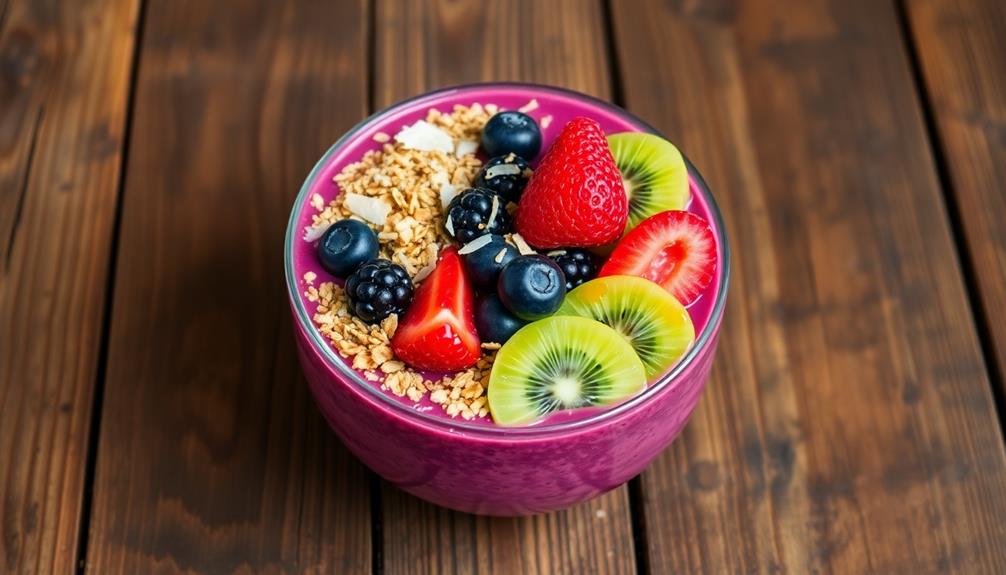
Smoothie bowls are all the rage these days, blending together delicious fruits and superfoods into a beautiful and nutritious breakfast. You'll be amazed at the vibrant colors and fun designs that people create, making these bowls totally Instagram-worthy. Just imagine a creamy smoothie as your base, topped with crunchy granola, juicy berries, and a sprinkle of toasted coconut – yum! Preparing these bowls at home lets you get creative, and the options are endless. Want to learn more about crafting your own smoothie bowl masterpieces? Keep reading to discover the secrets behind these visually stunning and satisfying treats.
Key Takeaways
- Smoothie bowls have gained immense popularity on social media due to their visually appealing and creative presentation, making them Instagram-worthy breakfast options.
- Vibrant ingredients, intricate designs, and themed arrangements contribute to the artistic appeal of smoothie bowls, allowing for self-expression and showcasing on social media platforms.
- Smoothie bowls are not only aesthetically pleasing but also nutritionally dense, with customizable ingredients providing essential vitamins, minerals, and fiber to support overall health.
- The transformation in flavor and texture, from blended smoothie to a frozen, ice cream-like consistency, creates a unique and refreshing breakfast experience.
- Topping suggestions such as crunchy granola, juicy berries, toasted coconut, and drizzles of honey or nut butter further enhance the visual appeal and flavor complexity of smoothie bowls.
History
Although smoothie bowls have been around for decades, the art of creating intricate designs and patterns on their surfaces has gained significant popularity in recent years. You can thank social media and the rise of "foodie" culture for this tasty trend!
Suddenly, people couldn't just blend up a nutritious smoothie – they'd to turn it into a colorful masterpiece, complete with fresh fruits, nuts, seeds, and all sorts of eye-catching toppings.
This Instagram-worthy craze started popping up in trendy cafes and health food stores, where baristas and chefs showcased their smoothie bowl creativity. Soon, home cooks got in on the action, experimenting with different flavor combinations and decorative techniques to make their breakfasts as beautiful as they're delicious.
From swirling nut butters to arranging berries in vibrant patterns, the possibilities for smoothie bowl art are endless. Whether you're a seasoned pro or just starting out, get ready to have fun and make your morning meal a true work of art!
Recipe
Smoothie bowls are a delightful way to enjoy a nutritious and visually appealing breakfast or snack. These frozen blended concoctions aren't only packed with essential vitamins and minerals but also allow for endless creative possibilities.
Transforming a simple smoothie into an edible work of art is a fun and engaging activity that the whole family can enjoy. Whether you're a seasoned smoothie enthusiast or new to the world of blended beverages, this recipe will guide you through the steps to create a visually stunning smoothie bowl.
Get ready to impress your friends and nourish your body with this delicious and Instagram-worthy treat.
Ingredients:
- 1 cup frozen mixed berries
- 1 banana, frozen
- 1/2 cup almond milk
- 1 tablespoon honey (optional)
- 1 tablespoon chia seeds
- 1 tablespoon granola
- Assorted fresh fruit (such as sliced kiwi, strawberries, and blueberries)
- Toasted coconut flakes (optional)
Instructions:
Combine the frozen mixed berries, banana, almond milk, and honey (if using) in a high-speed blender. Blend until smooth and creamy.
Pour the smoothie into a bowl. Sprinkle the chia seeds and granola on top. Arrange the assorted fresh fruit and coconut flakes (if using) in a visually appealing design on the smoothie. Serve immediately and enjoy your masterpiece!
Tips:
For a thicker consistency, use less almond milk. Adjust the sweetness to your liking by adding more or less honey.
Feel free to experiment with different fruit combinations and toppings to create your own unique smoothie bowl. Have fun and let your creativity shine through!
Cooking Steps
Blend your favorite frozen fruit and yogurt until smooth and creamy.
Pour the vibrant mixture into a bowl, then get creative by topping it with fresh fruit, nuts, seeds, or even a sprinkle of toasted coconut.
For an icy treat, stick the whole bowl in the freezer overnight and enjoy your delicious smoothie bowl the next day!
Step 1. Blend Frozen Fruit and Yogurt

Gather your blender and dive into the vibrant world of frozen fruit and creamy yogurt. The possibilities are endless when it comes to creating your own delectable smoothie bowl masterpiece. Start by choosing your favorite frozen fruit – maybe it's sweet and juicy mango, or perhaps tart and refreshing raspberries are more your style. Toss those frozen gems into your trusty blender, then add a generous scoop of thick, tangy yogurt.
For an added boost of nutrition, consider incorporating some fresh herbs like mint for a refreshing twist, as seen in unique combinations enhance flavor. Blend until the mixture is smooth and creamy, just the way you like it. You can also experiment by using these fresh herbs in classic cocktail recipes, adding a natural, healthful element to your drinks. Whether it’s muddling basil into a homemade mojito or garnishing a mint julep, these herbs provide layers of complexity while boosting both flavor and nutrition. Don’t hesitate to get creative and explore how fresh ingredients can transform both your beverages and your well-being.
Now, the real fun begins! Carefully pour your frozen fruit and yogurt blend into a bowl, creating a blank canvas for your edible artwork. Grab an assortment of fresh fruit, nuts, granola, and any other tasty toppings that catch your eye.
Artfully arrange these vibrant ingredients to transform your smoothie bowl into an Instagram-worthy breakfast that's almost too pretty to eat – almost! With each spoonful, savor the burst of flavors and the satisfying crunch of your customized creation.
Step 2. Pour Into Bowl
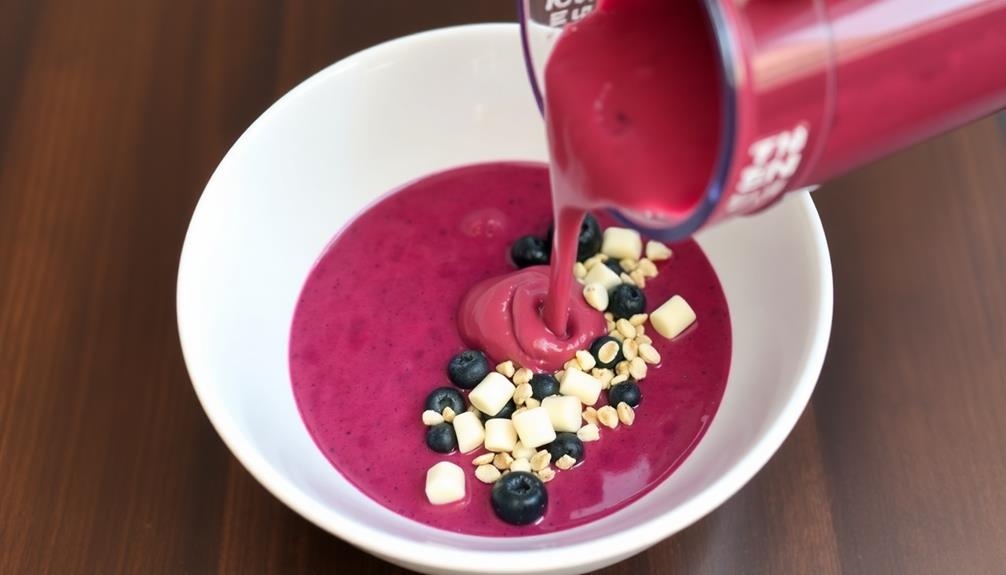
With your blended fruit and yogurt mixture ready, it's time to pour the luscious, creamy concoction into a bowl, creating a blank canvas for your edible masterpiece.
To enhance your smoothie bowl experience, consider adding a soothing herbal tea like chamomile on the side, known for its calming effects.
Grab your favorite bowl – maybe one with a pretty pattern or a bright, cheerful color. Slowly and carefully, pour the smooth, thick smoothie into the bowl, making sure to get every last delicious drop.
Watch as the vibrant purples, oranges, and greens swirl together, just waiting for you to transform them into a work of art.
Now it's time to get creative! Grab your toppings – things like fresh berries, toasted coconut, crunchy granola, or a drizzle of nut butter.
Arrange them in fun, colorful designs, letting your imagination run wild. Will you make a smiley face with banana slices? Or maybe a rainbow with vibrant fruit?
The possibilities are endless! Just have fun and get ready to impress your friends and family with your smoothie bowl masterpiece.
Step 3. Garnish With Fresh Toppings
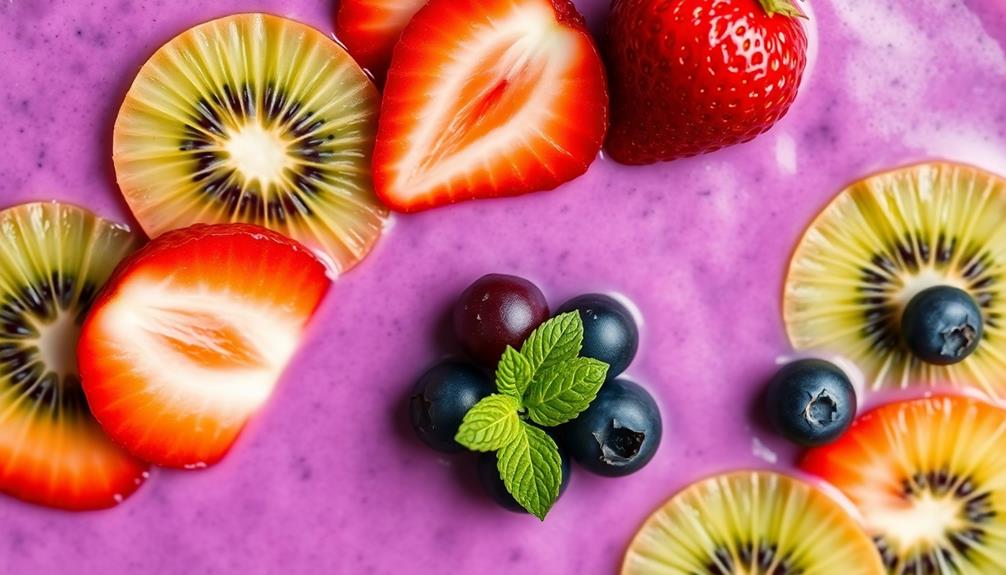
After you've poured the smoothie into the bowl, it's time to add the finishing touches. Grab a handful of fresh, colorful toppings and start arranging them on top of the creamy smoothie base.
Slice up some juicy strawberries and scatter them around the edges, creating a bright red border. Strawberries aren't only delicious but also rich in vitamin C, which can help promote skin health and give you that radiant glow benefits of vitamin C.
Sprinkle on a few plump blueberries, their deep purple hue providing a nice contrast. Don't forget the banana slices – they add a sunny, tropical vibe to your creation.
For a finishing touch, sprinkle on a sprinkling of toasted coconut flakes, their sweet, nutty flavor complementing the smoothie perfectly.
Step back and admire your work – your smoothie bowl is now a true work of art, ready to be shared on Instagram and enjoyed.
With all these vibrant, fresh toppings, your breakfast isn't only delicious, but visually stunning too.
Step 4. Sprinkle With Toasted Coconut
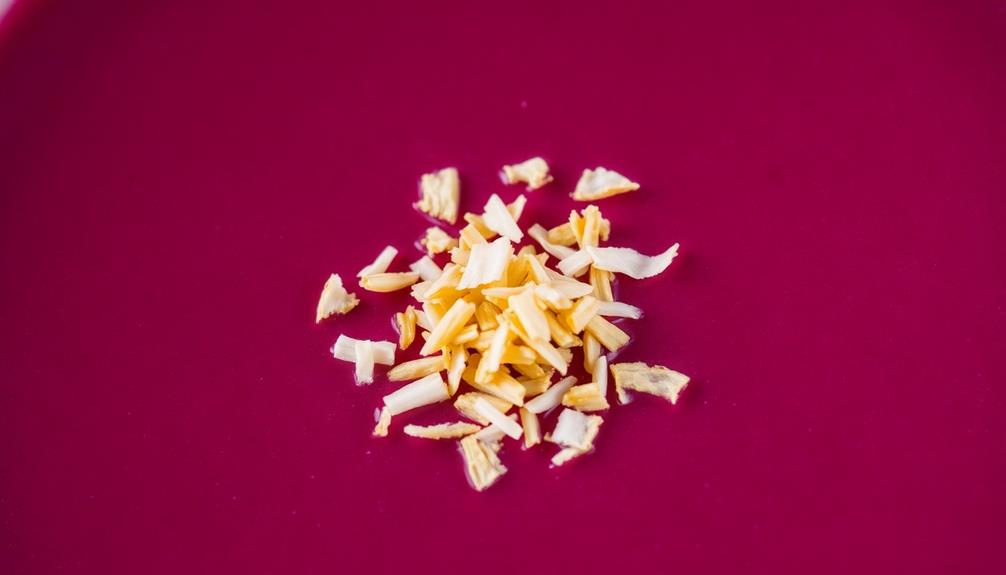
To elevate your smoothie bowl even further, sprinkle a generous amount of toasted coconut flakes over the top. The golden-brown, crunchy pieces will add a delightful texture and a sweet, nutty flavor that perfectly complements the fresh fruit and creamy yogurt.
Imagine the aroma of the toasted coconut wafting through the air as you take your first bite.
The toasted coconut flakes are easy to prepare – simply place them in a dry skillet over medium heat and cook, stirring occasionally, until they turn a lovely golden brown.
Be sure to keep a close eye on them, as they can go from perfectly toasted to burnt in the blink of an eye!
Once they've reached that delicious, toasted perfection, remove the skillet from the heat and let the coconut cool slightly before sprinkling it over your smoothie bowl.
The combination of the smooth, creamy smoothie and the crunch of the toasted coconut is simply irresistible.
Go ahead, give it a try – your taste buds will thank you!
Step 5. Freeze Smoothie Bowl Overnight

Freeze your smoothie bowl overnight for a delightfully chilled and thick treat in the morning.
You'll be amazed at how the flavors meld and the texture transforms when your vibrant, fruity creation sits in the freezer. Simply prepare your smoothie as usual, then pour it into your favorite bowl.
Pop it in the freezer, and let the magic happen! In the morning, you'll have a deliciously frozen breakfast that's almost like ice cream. Just give it a few minutes to thaw slightly, then dig in with a spoon.
Top it with all your favorite toppings – maybe some crunchy granola, juicy berries, or toasted coconut. The frozen smoothie will keep you feeling full and satisfied until lunchtime.
It's a delightful way to start your day, and your Instagram followers will be drooling over your artful masterpiece!
Final Thoughts
Creativity in the kitchen can be a source of profound satisfaction. Crafting eye-catching smoothie bowls allows you to unlock your inner artist and share your masterpieces with the world.
Whether you prefer vibrant, fruit-filled creations or earthy, veggie-based designs, the possibilities are endless.
As you continue your smoothie bowl journey, don't be afraid to experiment. Mix and match different ingredients, textures, and colors to find what inspires you.
The best part? Your unique smoothie bowl art can brighten someone's day and spread joy through the power of a delicious, nutritious breakfast.
Frequently Asked Questions
What Are the Best Fruits to Use in a Smoothie Bowl?
When crafting your smoothie bowl, consider using a variety of fresh fruits like bananas, berries, mango, and pineapple. These vibrant ingredients not only taste great but also create a visually appealing and nutrient-dense foundation for your customized breakfast creation.
How Can I Make My Smoothie Bowl More Visually Appealing?
To make your smoothie bowl more visually appealing, try arranging your fruits and toppings in a decorative pattern. Add a drizzle of nut butter or honey for texture and contrast. Get creative with colorful ingredients to make your bowl pop.
Is It Necessary to Use a Blender for a Smoothie Bowl?
You don't necessarily need a blender to make a smoothie bowl. You can simply chop up the ingredients and mix them together in a bowl. This method may not create as smooth a texture, but it can still be visually appealing.
Can I Make a Smoothie Bowl the Night Before?
You can make a smoothie bowl the night before, but it's best to assemble it right before serving. Preparing it ahead of time may result in a watery or separated texture, so it's better to blend and layer it fresh.
How Do I Store Leftover Smoothie Bowl Ingredients?
You can store leftover smoothie bowl ingredients in airtight containers in the fridge. The fruits and veggies will stay fresh for 3-4 days, so you can easily prep them ahead of time for a quick breakfast.
-

 Southern Comfort Food1 month ago
Southern Comfort Food1 month agoCheese Straws
-

 Brazilian Cuisine1 month ago
Brazilian Cuisine1 month agoCaldeirada
-

 Southern Comfort Food1 month ago
Southern Comfort Food1 month agoCreamed Corn
-

 Brazilian Cuisine1 month ago
Brazilian Cuisine1 month agoChicken in Brown Sauce
-

 Brazilian Cuisine1 month ago
Brazilian Cuisine1 month agoTacacá
-
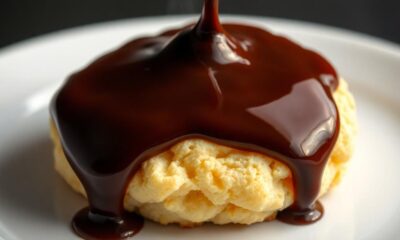
 Southern Comfort Food1 month ago
Southern Comfort Food1 month agoChocolate Gravy
-

 Southern Comfort Food1 month ago
Southern Comfort Food1 month agoSquash Casserole
-

 Polish Comfort Food1 month ago
Polish Comfort Food1 month agoKrupnik (Barley Soup)



























